The Cost of ObamaCare For Individuals, Families, Taxpayers, and the Government







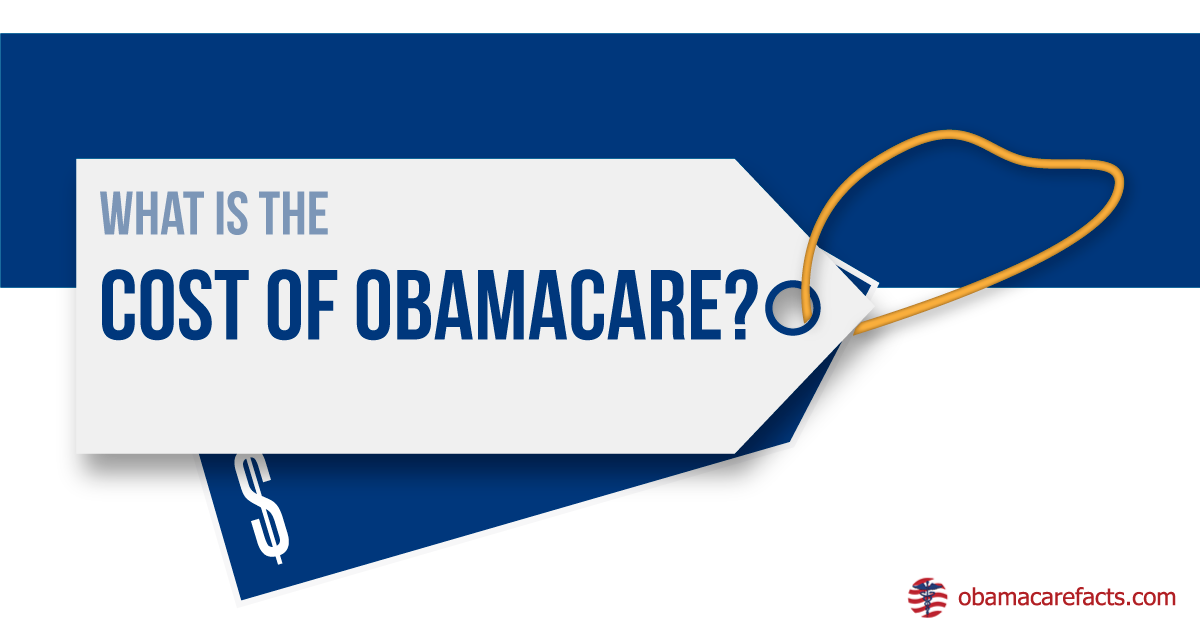
What Does ObamaCare Cost?
Below we look at what ObamaCare costs individuals and families, what ObamaCare costs taxpayers, and what ObamaCare costs in terms of government spending.
FACT: The Affordable Care Act (ObamaCare) lowers costs based on income. Plans costs less than $100 a month for the majority of Americans who qualify for assistance each year.
What Will ObamaCare Cost Me?
The national average monthly cost of the lowest cost plan under ObamaCare before cost assistance in 2021 is $328 for Bronze, $436 for Silver, and $482 for Gold.[1]
With that noted, the costs of health plans vary by a limited set of factors including plan, region, age, family size, and what type of assistance you qualify for based on income.
Also, when accounting for plan cost you should think about out-of-pocket spending and related limits like deductibles.
In practice, the monthly cost of an individual plan under ObamaCare ranges from free to low-cost (for Medicaid/CHIP) to hundreds of dollars (for older Americans without assistance options on higher-tier plans).
With that said, cost assistance can greatly reduce both premium and out-of-pocket costs. In fact, plans cost less than $100 a month for the majority of Americans who qualify for assistance (this is generally true each year due to the way assistance works).
To qualify for assistance, you must obtain a plan sold on the federal or state health insurance marketplace during each year’s open enrollment period or during special enrollment if you qualify.
Meanwhile, tens of millions can get free or low-cost coverage via Medicaid/CHIP and many can get assistance with out-of-pocket costs as well.
For those who don’t qualify for assistance, costs can also be impacted by limited factors like if you are a smoker or not, can differ between short term and major medical plans sold on the marketplace, and are subject to change each year (see a list of average costs for the year by checking out each state’s “Second Lowest Cost Silver Plan“).
Learn more about cost assistance on 2021 plans, check out what a plan will cost after assistance using our 2021 eligibility calculator, or go directly to HealthCare.Gov to see what a plan will cost you.
FACT: Due to the insurance-related provisions, many Americans can get covered for $100 or less on the Health Insurance Marketplace after Premium Tax Credits. Further, many Americans can qualify for out-of-pocket cost assistance and many more individuals and families will qualify for free or low-cost coverage under Medicaid and CHIP.
What Does ObamaCare Cost in Terms of Taxes?
The average American will pay little to no taxes related to ObamaCare. It is the same for small employers. Instead, many individuals and small businesses will qualify for tax credits and other forms of cost assistance under ObamaCare. With that said, there are a range of taxes in the ACA that some will owe (taxes are mostly on the healthcare industry, higher-income Americans, and large businesses).
What Does ObamaCare Cost in Terms of Government Spending?
The CBO has given different estimates of ObamaCare’s cost at different times.
ObamaCare’s cost to the government was estimated at a net cost of $1.207 trillion dollars by 2025 in 2015 by the CBO (a revision of the $1.1 trillion projection from 2012 that was settled on after some previous estimates of $900 billion and $1.76 trillion). That estimate included the cost of ObamaCare’s major insurance-related provisions but didn’t take into account all of the cost-curbing measures in the law.
With that in mind, specific cost projections are subject to change, have changed more than once as noted, and have been impacted by changes to the law since 2015 (especially changes under the Trump administration). For an example of changes that impact cost projections, the data above does not account for the lack of revenue that reducing the mandate’s fee to zero starting in 2019 will result in.
FACT: In 2015, due in part to the ACA, health-care spending grew at the slowest rate on record (since 1960). Meanwhile, health care price inflation is at its lowest rate in 50 years.
NOTE: The data on government spending is from 2015 when the CBO did an assessment of the ACA specifically. You can see the 2018 long-term budget outlook by the CBO for the latest numbers on healthcare spending (which includes Medicare, Medicaid, CHIP, ACA spending, etc). One important thing to note here is the budgetary impacts of repealing the fee for not having coverage (it generally means less income to offset spending). For more information, please see the latest CBO reports as they relates to the ACA for current healthcare spending estimates.
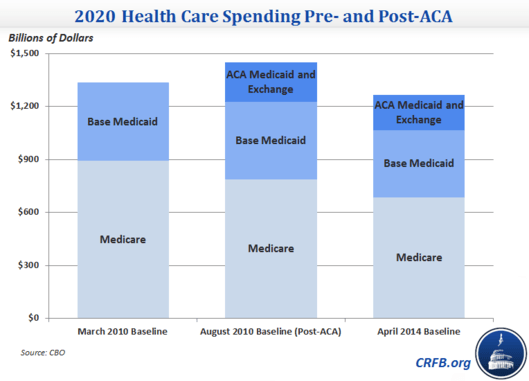
This graphic looks at the 2010 baseline compared to 2014. The idea here is to show there wasn’t a dramatic difference in spending after the ACA went into effect.
Moving On
The rest of this page will focus on the above three subjects. First we will cover costs for individuals and families, then taxes, and then government spending.
More on the Cost of ObamaCare For Individuals and Families
NOTE: Some of the specifics below need to be updated for 2019 and beyond. Aside from specific dollar amounts and percentages (which change every year and are generally used as examples below), the information should still be useful and relevant to any year.

Cost of ObamaCare Image Public Domain
Here are some quick bullet points on the cost of ObamaCare:
• ObamaCare is an informal term for our new health care law the Affordable Care Act or ACA for short. The law doesn’t sell health insurance – it creates a marketplace for Americans to buy regulated, subsidized private insurance.
• Most Americans have to either obtain health insurance known as minimum essential coverage and maintain it throughout the year or pay a Shared Responsibility Fee for every month they go without coverage. NOTE: The fee is reduced to $0 in most states for 2019 forward.
• If you don’t have coverage, or don’t like your current coverage, you can use the new health insurance marketplace to buy a private insurance plan.
• Health insurance can only be obtained during open enrollment in the individual market. This is true inside and outside the marketplace.
• You can also use the marketplace to switch plans and verify income. In 2015, be sure to shop around for the best deal, and verify your information to ensure that you are getting the right cost assistance.
• Many Americans will qualify for lower costs on monthly premiums and out-of-pocket costs via cost assistance subsidies through the marketplace.
• Cost assistance is based on income.
• Cost assistance includes Premium Tax Credits, which lower monthly premiums, and Cost Sharing Reduction subsidies, which lower out-of-pocket costs like copays, coinsurance, deductibles, and out-of-pocket maximums.
• If you have access to affordable employer-sponsored insurance, you won’t be eligible for subsidies.
• In 2014, the average subsidy on a Silver plan was $276 a month. The average cost of coverage before subsidies was $345 a month for a Silver plan. The average cost after cost assistance subsidies for the 87% of those who qualified for cost assistance was about $69 a month for a Silver plan.
• Post open enrollment data shows that, after tax credits, the average marketplace plan costs less than $100 a month for nearly 70% of enrollees and less than $50 for over 45% of enrollees.
• State-by-state reports on premium growth show that they are rising slower than or equal to historic rates, indicating that the ACA is truly curbing the growth of premiums despite concerns that the new benefits, rights, and protections would lead to premium growth.
• Most young people and low-income Americans can get free or very low-cost, high-quality health insurance through the marketplace.
• You can only get cost assistance from the Health Insurance Marketplace!
• The average American will pay between roughly 2% – 9.5% of their income on insurance after cost assistance.
• Insurance costing 8% of your income is considered affordable insurance for individuals. Insurance costing 9.5% is considered affordable for job-based insurance.
• If you cannot find affordable insurance after cost assistance, you may be exempt from the fee (in instances where the fee would be owed).
• ObamaCare says health insurance companies can price your insurance based on location, family size, age, and smoking status, but not on health status or gender.
A recent study showed the price for a 21-year-old buying a mid-range policy would average about $270 a month before cost assistance. With cost assistance, that 21-year-old could pay much less. Over 80% of 21-year-olds in the US will be eligible for cost assistance, meaning they will be paying as little as 1/10th of that $270 cost per month for quality health insurance, and many may even get insured for free.
Post open enrollment data showed the average marketplace plan price was $82 after tax credits in 2014. Every year the average plan price has been under $100 due to the way cost assistance caps spending based on income (of course, that also means the government has to spend more as the base rates go up).
Wondering What ObamaCare Will Cost You? The Average American will qualify for major cost assistance! To qualify for assistance, you must use the Health Insurance Marketplace to purchase your insurance!

How Much Will Health Insurance Cost Me?
Everyone’s costs are different. Not only do costs change each year in general, but health insurance costs differ by family size, age, smoking status, plan choice, region, state, and income. Typically premium costs rise each year, and so do limits on cost-sharing amounts.
The above being said the second lowest cost SILVER plan is the standard baseline plan of the ACA, and each year the average cost of these plans in each state is published. By looking that up, you can find the average cost plan before assistance.
Meanwhile, the lowest cost BRONZE plan is going to be a cheaper option, and you can find these averages each year too when they are published.
Unfortunately, costs can differ greatly by region, and you can end up paying far more in some of America’s highest-cost regions. Rural regions and regions with a lot of wealth tend to have high costs, while regions with less wealth and a lot of healthcare providers per capita tend to have lower costs.
All that said, because of the way assistance works, many will pay less than $100 after cost assistance, and millions get free coverage through Medicaid and CHIP.
Each year everyone also has some costs limited. For example in 2019, your out-of-pocket maximum can be no more than $7,900 for an individual plan and $15,800 for a family plan before marketplace subsidies. This rate adjusts each year (see current maximums). (TIP: You can use an HSA to take advantage of having a high deductible plan.) In other years you’ll still have a cap, but the specific amount of spending is capped by will change.
The biggest factor in premium cost is income, due to the fact cost assistance is based on income. The less you make, the less you pay (assuming you will be using the Health Insurance Marketplace to shop for health coverage).
In 2014 the average cost after subsidies was $82 per month for all plans for those who shopped on the marketplace, but those who shopped outside of the marketplace saw an increase in their premium from previous years under the Affordable Care Act. This trend has continued in both respects. Although moving forward, premium increases are projected to slow down; prices can be expected to rise each year regardless of what reforms are in place.
The Lowest Costs Plans in Each State
This breakdown of the second lowest cost silver and lowest cost bronze plan and their price changes between 2014 and 2015 will give you a solid idea of what prices looked like before cost assistance and capped at roughly 9.5% of income for someone making 400% of the Poverty Level. For more information on how those amounts can be lower with cost assistance, see our page on subsidies.
Keep in mind that in some regions, and thus for some families, costs can be much higher than the lowest cost in the region. If you live in an expensive region and don’t have access to cost assistance you could end up paying far more than the majority of Americans for coverage.
This video will help you understand some of the factors that affect your health insurance costs and the benefits of buying a plan on the exchange:
ObamaCare Cost Calculator
How much will health insurance cost you under ObamaCare? The easiest way to figure this out is to go to healthcare.gov or your state’s marketplace and apply. If you want to shop around, you can also the use of third-party tools (listed below) or contact a broker outside of the marketplace for quotes. Cost depends on factors such as income, region, family size, and the type of plan you choose. Please note some cost assistance is only available for certain plans.
You can get an estimate of what your health insurance will cost on the marketplace by going to the health insurance premium estimate tool from healthcare.gov.
Third Party Subsidy and Plan Cost Estimators
You can use this ObamaCare cost calculator to get an idea of what kind of subsidies you are eligible for, or you can try one of the other cost calculators below. Remember, cost assistance is only offered through your state’s Health Insurance Marketplace.
- Obamacare Subsidy Calculator Provided by: SubsidyCalculator.com
- Use the Kaiser Calculator. The calculator will give you an idea of what type of cost assistance you qualify for and will give you an idea of what a plan will cost after cost assistance in your region.
- Use the ehealthinsurance.com subsidy calculator. This tool will help you to see if you qualify for cost assistance and will give you the option to shop for quotes outside of the marketplace.
Please be aware that these estimates are often based on the cost of a “Silver plan” (the second tier plan, as opposed to the basic “Bronze plan” on the marketplace). Also, note that the total cost is greatly affected by “regional cost factor” (increasing or decreasing the premium by 20%). Additional subsidies may be available depending on other factors.
Please note that the ObamaCare Cost Calculators use modified adjusted gross income and not total gross income or net income to figure out cost assistance and insurance cost estimates.
Also note that as little as a $1 difference in income can exclude you from receiving a subsidy.
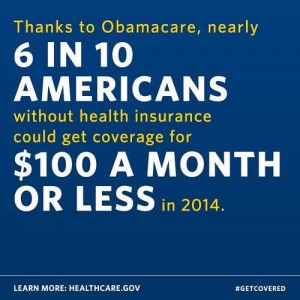
Factors that Affect What You Will Pay for ObamaCare Health Insurance
Wondering what you will pay for ObamaCare health insurance? ObamaCare does away with pre-existing conditions and gender discrimination, so you can no longer be charged more or denied coverage due to your medical history or gender. Factors that still affect what you will pay for health insurance under ObamaCare are location, income, smoking status, and age.
A case study showing how ObamaCare’s costs work in regards to subsidies through the State marketplaces: “Affordable insurance” is capped at a percentage of your taxable income (the less you make, the lower the cap). While age affects the cost of your premium before subsidies are applied, smoking results in a “tobacco surcharge.”
In other words, a 27-year-old non-smoking male with no pre-existing condition who is living in New Haven CT and making 200% of the FPL has an insurance cost equal to a 55-year-old non-smoking female with a pre-existing condition who is living in New Haven CT and making 200% of the FPL. They will both pay the same amount for the same plan on their State’s health insurance marketplace (Access Health CT) after premium subsidies are taken into account. They will have access to the same out-of-pocket cost assistance as well.
The reason their costs are the same is the cap on the percentage of income a heath plan bought on the marketplace can cost; in their case, the premium cap is 6.3% since they make 200% of the Federal Poverty Level. Although the premium cost before subsidies would be higher for the older individual, premium subsidies paid directly to the insurance company result in their personal payments being the same. However, if one of them smoked, that person would pay more since those costs are considered premium surcharges and are added on after subsidies are calculated.
• You can’t be charged more for health insurance due to health status or gender, but you can be charged more based on income, family size, location, age and smoking status.
• Smokers can expect to pay up to 50% more than non-smokers for the same health plans. Subsidies are calculated before the “tobacco surcharge,” thus smokers could find their theoretically affordable insurance to be unaffordable.
The following video will give you a simple explanation of what ObamaCare Subsidies are and how they work:
This video explains how ObamaCare Subsidies work in a little more detail:
The Cost of Health Insurance Plans: Types of Health Insurance Plans Offered on the Marketplace and their Actuarial Value
The cost of ObamaCare plans depends upon the quality of plan you choose to purchase. The least expensive plan, the bronze plan, covers 60% of out of pocket health care costs and offers basic coverage. In other words, it has a 60% actuarial value. Plans range from the basic “Bronze” (60%) to “Silver” (70%) to “Gold” (80%) and “Platinum” (90%) level plans. Each plan has better benefits and networks progressively, and each is progressively more expensive. High-end plans carry a 40% excise tax to help pay for the program.
The nationwide average price of a Bronze plan for 2014 was about $250 a month before cost-assistance and 82$ after. The total annual fee for not buying insurance can’t be more than the average price of a Bronze plan. Learn more about the Individual Mandate.
Please note that the health insurance costs under ObamaCare represented below are the base cost of premiums for a Bronze plan before subsidies. Many uninsured Americans will qualify for cost assistance or qualify for free coverage through the Health Insurance Marketplace.
NOTE: The chart below is from 2014, it gives an idea of where costs were. I need to update this with current costs.
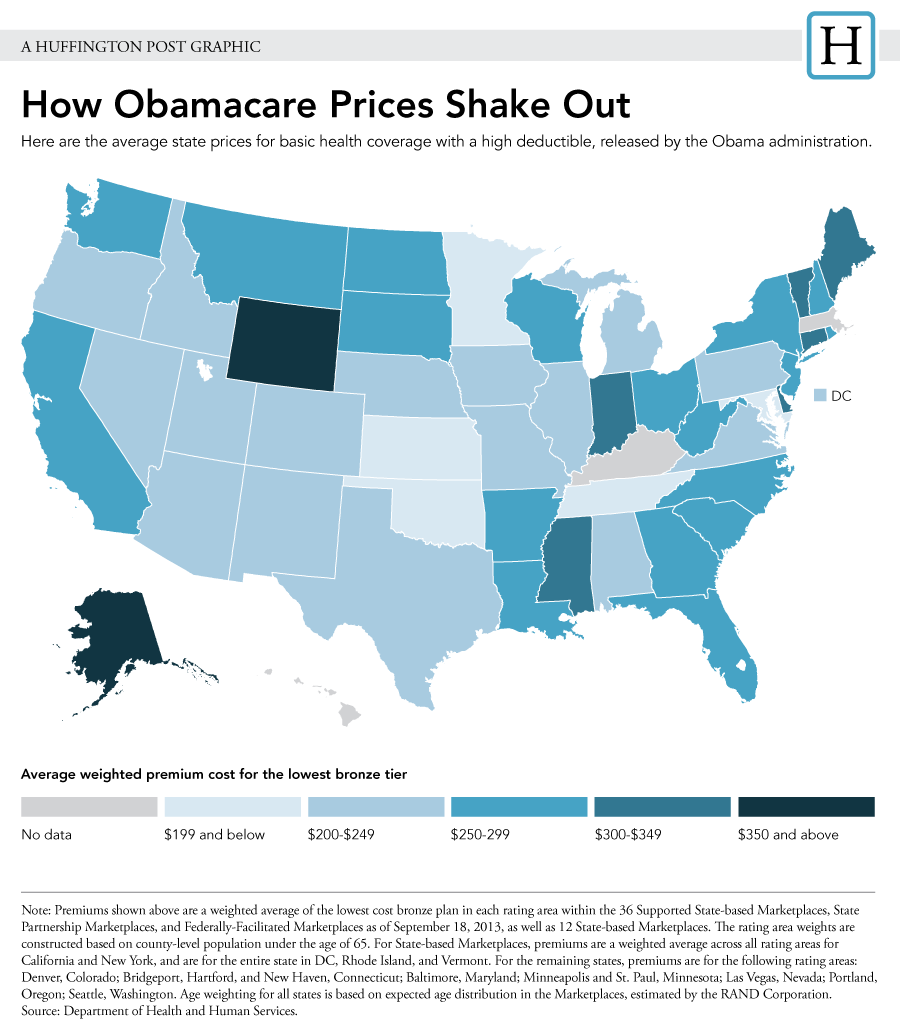
How Much Does ObamaCare Cost The Average American?
In 2016, “Bronze” plans for individuals are expected to cost between $4,500 and $5,800 a year. However, if you make less than 4 times the Federal poverty line (about $45,000 for an individual in 2012), you’ll pay less by receiving tax credits. Someone making up to 133% of the FPL will get credits such that his net payment will be only 2% of income. Meanwhile, those making 300% to 400% of FPL will pay 9.5% of FPL. Please see the FPL chart below for more details.
Please note that, while ObamaCare regulates insurance companies, you will still be purchasing private insurance (unless you choose to pay the penalty or are already covered).
You can use the quote tool below to get an idea of what a marketplace coverage will cost you and to request health insurance quotes. Learn more about how to buy health insurance for 2016 and beyond.

Costs of ObamaCare for Small Businesses
While most people and small businesses in the United States will benefit from Obamacare, Obamacare will cost employers with over 50 full-time employees a penalty if they do not choose to provide their workers with affordable, quality health care. The tax is $2000 per worker or $3000 if they buy insurance through the exchange.
This system is like the current unemployment tax already in effect, which requires American businesses to pay a modest and fair tax to aid the state run unemployment and workers compensation programs. With ObamaCare, the penalty helps pay for workers who will buy insurance through the exchange or need emergency services, both which will drive the cost of health care up for the rest of us.
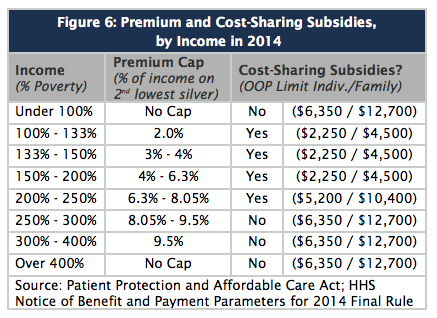
This image from 2014 showing premium assistance is used as an example. The premium caps and cost-sharing subsidy limits change slightly each year. See current subsidy caps here.
Types of ObamaCare Cost Assistance: Marketplace Cost Assistance
There are three types of cost assistance offered through the Health Insurance Marketplace tho those making under a certain amount of income who don’t have access to employer-based insurance. Medicaid / CHIP for those making less than 138% of the Federal poverty level (FPL), help with out-of-pocket costs for those making up to 250% of the FPL and premium tax credits for those making up to 400% of the FPL. You may qualify for both premium and cost-sharing subsidies as they are not mutually exclusive. Cost assistance is only available through your State’s health insurance marketplace.
Who Qualifies for Help With ObamaCare Insurance Costs?
The following chart will help you to find out who qualifies for help with insurance costs on the health insurance exchanges under The Affordable Care Act. With that said, since the 2019 chart is featured below you should note all the numbers have been revised upward. Please see the latest federal poverty level table for the correct and most recent numbers.
| Types of Cost Assistance: Health Insurance Financing | Individual Annual Income | Family of Four Annual Income |
| Medicaid health coverage, if your state decides to offer it |
Up to $17,236 | Up to $35,535 |
| Help to pay your premium, if you buy in your state’s online marketplace |
Between $11,670-$46,680 | Between $49,960-$103,000 |
| Subsidies for out-of-pocket costs, if you buy in your state’s online marketplace |
Up to $31,225 | Up to $64,375 |
Many American families will see a cost reduction under ObamaCare, and many more will qualify for Medicare and Medicaid due to the expansion of the programs. During open enrollments, you can use an online application form to apply for subsidies. Once you have a marketplace account, you can compare health insurance options with cost assistance applied to help you pick the right plan for you and your family.
Employers with under 25 full-time equivalent employees may qualify for tax credits and tax breaks through the small business part of the marketplace the Small Business Health Options (SHOP).
To ease the burden of Obama Care’s cost, 19 million Americans will receive tax credits to help pay for healthcare.
If you are making over 400% of the poverty line, you can expect to pay just about what you do now, but receive better coverage. If your income is below the poverty line, you will most likely save on health insurance costs. Individuals making between $50k and $75k annual gross income (9% of Americans) who don’t want insurance and will have to pay the 2.5% penalty (by 2016) will most likely see the biggest premium increases under the ACA.
See our page on Calculating Premium Tax Credits for detailed information on how the process of calculating credits works.
ObamaCare Cost-Sharing Reduction: Health Insurance Marketplace Cost-Sharing Subsidies
Cost-sharing subsidies protect lower income people with health insurance from high out-of-pocket costs at the point of service. ObamaCare provides for reduced cost sharing for families with incomes at or below 250% of poverty by making them eligible to enroll in health plans with higher actuarial values. The premium tax credits, discussed above, generally are based on a plan with an actuarial value of 70%. ObamaCare provides people with lower incomes with reduced cost sharing, so that plan on average pays a greater share of covered benefits. The amount of additional protection varies with income, as follows:
Income Level and Actuarial Value (the amount of costs a Silver plan will cover due to cost sharing reduction subsidies for % of the Federal Poverty Level).
- 100-150% FPL = 94% Actuarial Value
- 150-200% FPL = 87% Actuarial Value
- 200-250% FPL = 73% Actuarial Value
- More than 250% FPL = 70% Actuarial Value
Please use our updated federal poverty level chart to see if you qualify for out-of-pocket cost assistance.
Cost-sharing reduction lowers the amount you have to pay for out-of-pocket costs like deductibles, coinsurance, and copayments. These are costs you have to pay when you get care.
This video explains how cost sharing works and points out that many preventative services (including your check-ups are covered with no cost-sharing on all new health plans).
ObamaCare Tax Credits: What Are Marketplace Premium Tax Credits?
When and your family apply for health insurance through the Health Insurance Marketplace, you’ll be made aware if you are eligible for premium tax credits. Tax credits help to subsidize your premium costs resulting in lower monthly premiums for you and your family. The amount you receive in tax credits is based on your previous year’s Federal tax return. Tax credits are automatically paid to your insurance provider and are adjusted on your year end taxes based off of change in income for that year. If your income increases, you will be responsible for a larger share of your premium and that will be reflected on your year-end Federal tax returns.
How to Calculate Cost Assistance for Insurance Purchased on the ObamaCare Health Insurance Marketplace
Are you wondering how to calculate cost assistance offered on the Health Insurance Marketplace? The following chart will help you to understand how cost sharing subsidies and tax credits are calculated. Those between 133% of the federal poverty level and 400% will be eligible for cost assistance. The following chart will give you an idea of what type of cost assistance is available for an average family of four on the “Silver plan.” Please use our updated federal poverty level chart for a more accurate idea of who will qualify for cost assistance on the marketplace (amounts change every year).
The Chart Below is an Example chart from 2016 to illustrate of how cost assistance affects costs and assistance. Don’t use the actual numbers listed for official calculations. This chart needs to be updated.
Health Insurance Premiums & Cost Sharing under PPACA
Average Family of 4 For a “Silver Plan”
| Income % of FPL | Premium Cap as a Share of Income |
Income $ (family of 4) |
Max Annual Out-of-Pocket Premium |
Premium Savings | Additional Cost-Sharing Subsidy |
|---|---|---|---|---|---|
| 133% | 3% of income | $31,900 | $992 | $10,345 | $5,040 |
| 150% | 4% of income | $33,075 | $1,323 | $9,918 | $5,040 |
| 200% | 6.3% of income | $44,100 | $2,778 | $8,366 | $4,000 |
| 250% | 8.05% of income | $55,125 | $4,438 | $6,597 | $1,930 |
| 300% | 9.5% of income | $66,150 | $6,284 | $4,628 | $1,480 |
| 350% | 9.5% of income | $77,175 | $7,332 | $3,512 | $1,480 |
| 400% | 9.5% of income | $88,200 | $8,379 | $2,395 | $1,480 |
| In 2016, the FPL is projected to equal about $11,800 for a single person and about $24,000 for family of four. Use the Kaiser ObamaCare Cost Calculator or this updated Cost Calculator from Covered California for more information. DHHS and CBO estimate the average annual premium cost in 2014 to be $11,328 for family of 4 without the reform. Source: Wikipedia | |||||
ObamaCare Cost for the Average Family
The cost of ObamaCare for the average family differs based on several factors. Common estimates for an average family of 4 range from around $7,000 a year to $30,000 a year depending on factors such as plan choice, age, health status, access to cost assistance due to income, and region. To get a more in-depth look, please refer to our sections on the Health Insurance Exchanges, ObamaCare Premiums, ObamaCare Taxes and our study of the recent IRS report on ObamaCare.
NOTE: This study was done in 2014, costs have risen, but so have subsidy amounts.
Here is a case study of a family of four using the Kaiser Subsidy Calculator. The family has two adults who smoke and two children who don’t smoke. They make 149% of the Federal Poverty Level ($35,000). This shows a “Silver plan” costs $4,391 a year due to cost savings on their premium via tax credits and has 95% actuarial value due to out-of-pocket cost assistance. Remember the two types of cost assistance offered through the marketplace are help with out-of-pocket costs and help with premium costs. The family could pay less for a “Bronze plan” for $2,501 but have higher out-of-pocket costs, or more could pay more for a “Gold plan” and still receive subsidies. In their case, due to the way subsidies work, a “Sliver plan” probably makes sense since their out-of-pocket assistance drops significantly with a “Bronze plan” (it only pays 60% of out-of-pocket costs) and doesn’t increase with a “Gold plan” (although other benefits offered would).
- Household income in 2014:
- $35,000 which is 149% of poverty level
- Unsubsidized annual health insurance premium in 2014:
- $12,887 total
$3,018 of which is due to a tobacco surcharge - Maximum % of income you have to pay for the non-tobacco premium, if eligible for a subsidy:
- 3.92%
(before accounting for the tobacco surcharge) - Amount you pay for the premium:
- $4,391 per year
(which equals 12.54% of your household income and covers 34% of the overall premium) - You could receive a government tax credit subsidy of up to:
- $8,497
(which covers 66% of the overall premium)
Your out-of-pocket maximum for a Silver plan (not including the premium) can be no more than $4,500. Whether you reach this maximum level will depend on the amount of health care services you use. Currently, about one in four people use no health care services in any given year.
You are guaranteed access to a Silver plan with an actuarial value of 94%. This means that for all enrollees in a typical population, the plan will pay for 94% of expenses in total for covered benefits, with enrollees responsible for the rest. If you choose to enroll in a Bronze plan, the actuarial value will be 60%, meaning your out-of-pocket costs when you use services will likely be higher. Regardless of which level of coverage you choose, deductibles and copayments will vary from plan to plan, and out-of-pocket costs will depend on your health care expenses. Preventive services will be covered with no cost sharing required.
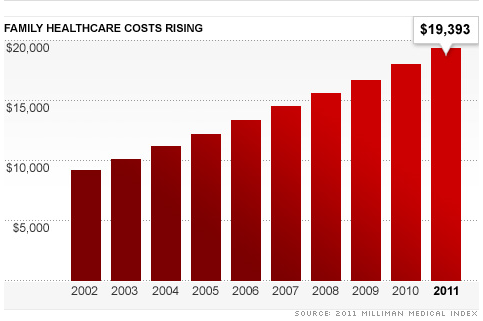 The Cost of ObamaCare: What is Considered Affordable Health Insurance?
The Cost of ObamaCare: What is Considered Affordable Health Insurance?
Currently, the average American family pays 20% of their income for health insurance. ObamaCare deems insurance that costs 8% of a family’s income as “affordable.” The less money you and your family make the smaller percentage of your income you will have to pay due to subsidies offered through the Health Insurance Marketplace. The average family’s costs are projected to decrease between 7% and 9% due to ObamaCare. We have seen costs range from free to an excess of $30,000 for an older, high-risk, high-income family of 5 in a state with high regional costs.
This graph represents combined health care costs for employees and employers. Employer-Based Health care costs for a family of four have doubled in less than a decade from $9,235 in 2002 to over $19,000 in 2011.
During the period from 2007 to 2010, per-capita health care spending rose just 1.8 percent annually. Since then, the annual increase has slowed even further, to 1.3 percent. While the Affordable Care Act has reduced the growth in healthcare spending as intended, many attribute some of this reduction to “the weak economy.”
Affordable Insurance: How Age and Subsidies Affect Your Insurance Costs
Let’s take a look at two case studies. In one scenario a 40-year-old single male who makes 250% of the federal poverty level wants to buy insurance, in the next scenario we see a 60-year-old single male who makes 250% of the federal poverty level who also wants to buy insurance. As you can see, age increases the cost of premiums before subsidies considerably. However, since both men have the same amount of income their cost after subsidies will be the same.
The following chart shows what a single 40-year old making 250% FPL will pay a month in 2014 both before and after subsidies. Remember age is a factor when pricing insurance, younger people can expect lower rates while older people, who don’t yet qualify for Medicare, should expect higher rates.
TIP: tThe numbers below are from 2014 and are meant as an example.
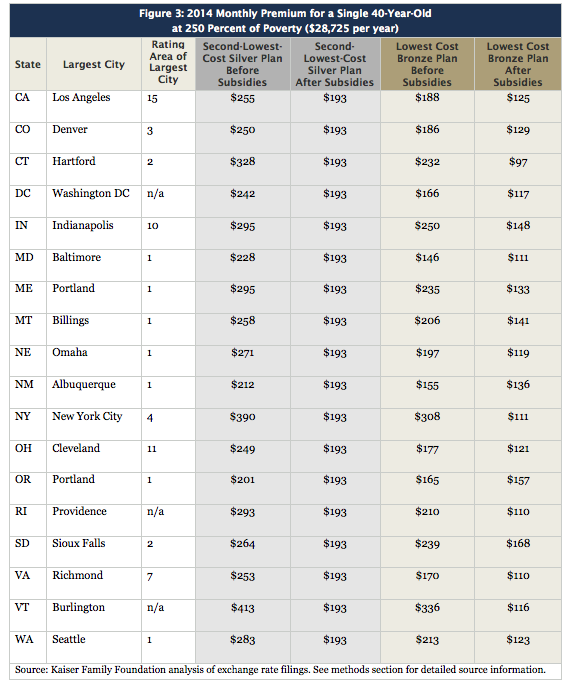
This next chart shows what a single 60-year old making 250% FPL will pay a month in 2014 both before and after subsidies. Remember that age is a factor when pricing insurance. Younger people can expect lower rates while older people, who don’t yet qualify for Medicare, should expect higher rates before subsidies.
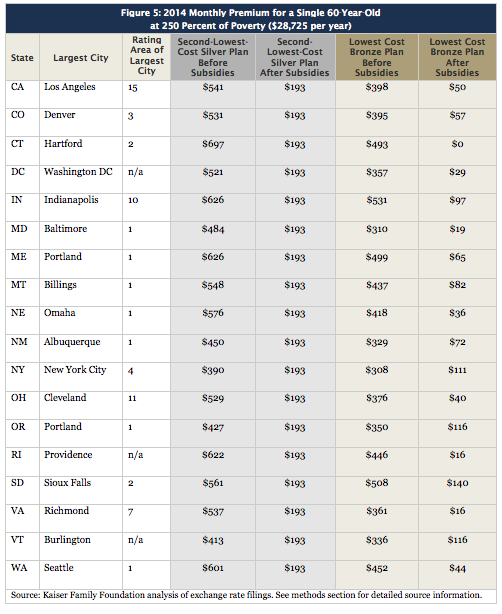
ObamaCare Cost for The Federal Government / Tax Payers
NOTE: The specifics below are based on projects from 2013 – 2015. So specific numbers will be off, but the gist will be correct (save for changes to the law that were unforeseen in 2013 like the mandate being reduced to zero). This note applies to the rest of the page.
ObamaCare’s net cost is estimated to be $1.36 trillion. This number is an updated estimate by a CBO report on ObamaCare’s costs from May 2013. However, some factors including taxes, fees, and penalties are expected to reduce the federal deficits by $210 billion over the 2012-2021 period.
Gross additional costs of ObamaCare include $1.5 trillion for Medicaid, the Children’s Health Insurance Program (CHIP), as well as tax credits and other subsidies for subsidized marketplace plans for individuals, families, and small businesses. These costs are offset by penalty payments, health care cost cuts, new health care industry taxes, and a 2018 excise tax on high-premium insurance plans.
About one-fifth of federal spending for the major health care programs (i.e. Medicare, Medicaid, CHIP, and marketplace subsidies for individuals, families, and small businesses) will finance care for non-disabled younger people. About one-fifth will go toward care for blind and disabled people. About three-fifths will go to care for other people who are age 65 or older.
If you want to know more about the cost of ObamaCare, please see the CBO Budget 2013-2014 or our resources page for more official documents detailing ObamaCare’s costs and how they fit into the US budget.
Update: A CBO report on the Affordable Care Act from December 2013 shows that over the past five years the Affordable Care Act has helped to decrease the growth in healthcare spending, which was one of the primary goals of the law. Medicare, Medicaid, and Subsidy spending are all projected to be substantially lower than initially projected.
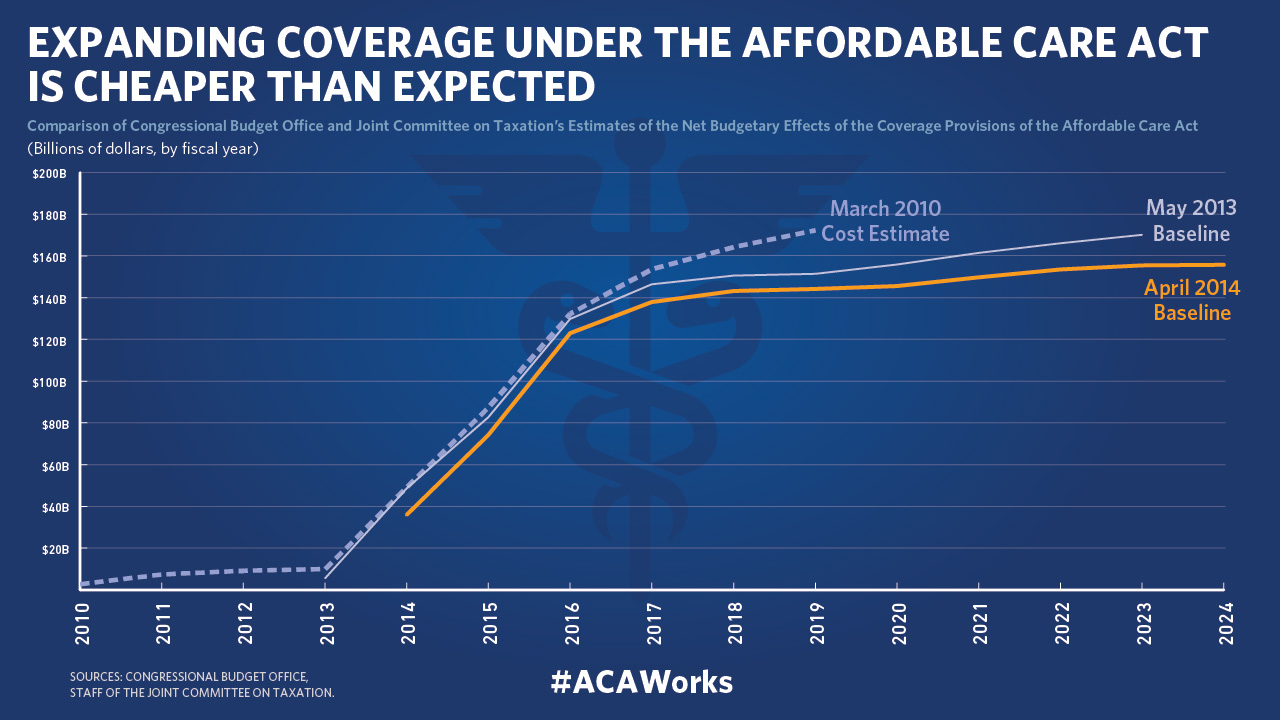
Update as of April 17th, 2014 on the effects of the ACA on healthcare costs from whitehouse.gov:
- Health care costs are growing at the slowest level on record: Since the law passed, real per capita health care spending is estimated to have grown at the lowest rate on record for any three-year period and less than one-third the long-term historical average stretching back to 1960. This slower growth in spending is reflected in Medicare, Medicaid, and private insurance.
- CBO projects the deficit will shrink more and premiums will be lower than expected. CBO estimated that the ACA would reduce the deficit by $1.7 trillion over two decades. Just this week, the CBO concluded that lower-than-expected Marketplace premiums and other recent developments would cut $104 billion from our deficit over the next ten years. The CBO report also projects that lower-than-expected premiums will help to save $5 billion this year and that lower premiums will persist in the years ahead, remaining 15 percent below projections by 2016 (the only year in which CBO provides a precise estimate).
- Medicare spending growth is down: Medicare per capita spending is growing at historically low rates. This week, for the fifth straight year, the CBO reduced its projections for Medicare spending over the next 10 years – this time by $106 billion. CBO projects that Medicare and Medicaid costs in 2020 will be $180 billion below its 2010 estimates. Recent economic research suggests that the ACA’s reforms to Medicare may have “spillover effects” that reduce costs and improve quality across the healthcare system, not just in Medicare.
Check out the CBO’s report on the effects on direct spending and revenues for health care programs to understand how ObamaCare helps to reduce the growth in health care spending by tens of billions each year.
Understanding Government Spending on HealthCare and the ACA
Below is some information to help you better understand government spending on healthcare and the ACA specifically.
- As of March 2015, the net cost of ObamaCare was projected to be $1.207 trillion over the 2016 – 2025 period.
- The cost was down from $1.35 trillion in January 2015, which itself represented a 7% reduction from April 2014.
- The net cost includes coverage provisions like Marketplace subsidies, the expansion of Medicaid and CHIP, and Employer tax credits.
- The net cost also includes revenue provisions like Penalty payments, the excise tax, and other taxes. NOTE: the fee for not having insurance is reduced to $0 2019 forward. Logically this will mean less revenue to offset spending on healthcare.
- The net cost doesn’t include other reforms, which continue to contribute to a downward trend in healthcare costs, including many Medicare-related reforms. Medicare spending is calculated separately in the budget projections, but Medicare reform comprises a bulk of the Affordable Care Act itself.
Obamacare Cost Projections
Although ObamaCare’s net costs are in the trillions, the law helps reduce the growth in health care spending by tens of billions each year. Cost curbing measures and reductions in health insurance costs for many Americans due to subsidies help to insure tens of millions by expanding coverage options. This expansion could potentially result in an overall net decrease of the deficit by driving health care costs down over time.
Obamacare was originally projected to cut the national deficit by over $200 billion during its first 10 years, and by over $1 trillion over the next two decades in March of 2012. Although estimates have changed, the law’s provisions continue to curb healthcare costs. This helps offset the current estimated $1.207 trillion net cost of ObamaCare’s insurance related provisions. (The gross cost of ObamaCare is $1,707 billion, offset by a projected $500 billion in revenue for 2016–2025.)
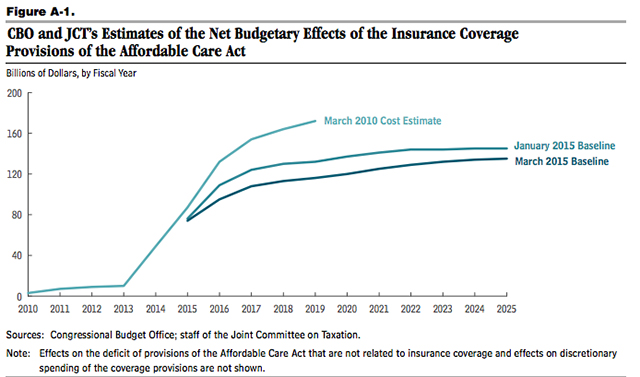
Please be aware the cost estimates are changed on a regular basis and are often quoted as being between $1 and $2.6 trillion depending on a variety of factors, such as when the report was done, who did the reporting, and the time-span that the report referenced.
Our cost estimates are taken directly from official CBO, reports, including January 2015 CBO report on ObamaCare’s costs and March 2015 updated estimates (page 15). To properly understand the budgetary effects of the law, we suggest a full reading of recent Congressional Budget Office (CBO) reports on the ACA spanning 2010 – 2015 including the March 2015 estimates for a current overview, and March 2011 estimates for an original overview.
Get a simplified explanation of how ObamaCare affects the Deficit and Debt.
How Do We Pay For ObamaCare Costs?
Many sections of the Affordable Health Care Act cover the cost of Obamacare and how we will pay for national healthcare reform over the next decade. Here are some of the measures that will help pay for the Obama’s healthcare reform:
• First, to help pay for the cost of Obamacare, businesses and families will pay an additional .9% tax on taxable income and 3.8% capital gains exceeding $200,000 / $250,000.
• Fees for not purchasing insurance will help to cover some of the cost of the law. If you choose not to purchase insurance (and can afford it) there is a 1% tax in 2014; it rises to a 2.5% tax in 2016, and then adjusts for inflation. This tax is the “income tax” you may hear about and is the only income tax hike in ObamaCare and the only tax most Americans will pay.
• Businesses with over 50 full-time equivalent employees will also pay a fee for not insuring full-time workers starting 2015.
• ObamaCare also cuts $716 billion from Medicare and invests it back into Medicaid, Medicare, and the healthcare system, so a lot of the money is coming from cutting waste, not just in Medicare, but in the healthcare industry as a whole.
Check out the CBO’s report on the effects on direct spending and revenues for health care programs to understand how ObamaCare helps to reduce the growth in health care spending by tens of billions each year.
How Do We Pay For ObamaCare Costs?
Many sections of the Affordable Health Care Act cover the cost of Obamacare and how we will pay for national healthcare reform over the next decade. Here are some of the measures that will help pay for the Obama’s healthcare reform:
• First, to help pay for the cost of Obamacare, businesses and families will pay an additional .9% tax on taxable income and 3.8% capital gains exceeding $200,000 / $250,000.
• Fees for not purchasing insurance will help to cover some of the cost of the law. If you choose not to purchase insurance (and can afford it) there is a 1% tax in 2014; it rises to a 2.5% tax in 2016, and then adjusts for inflation. This tax is the “income tax” you may hear about. It is the only income tax hike in ObamaCare and the only tax most Americans will pay.
• Businesses with over 50 full-time equivalent employees will also pay a fee for not insuring full-time workers starting 2015.
• ObamaCare also cuts $716 billion from Medicare and invests it back into Medicaid, Medicare, and the health care system, so a lot of the money is coming from cutting waste, not just in Medicare, but in the health care industry as a whole.
The Cost of Not Having ObamaCare
The cost of not having ObamaCare?: In a study by FamiliesUSA reported that each week 502 Americans die due to a lack of health insurance. That is 2,175 Americans dead each month. The true cost of Obamacare isn’t in healthcare costs and taxes; it’s in the lives of Americans like you and me.
The same study showed that between 2005 and 2010 that the number of people who died prematurely due to a lack of health coverage rose from 20,350 to 26,100 a year.
These figures are from 2010, Obamacare was signed on Oct. 1, 2010, and made its first steps toward providing quality affordable health insurance to individuals and families struggling with rising health care costs.
So while there are costs, it is both economic reform and healthcare reform that will decrease payments of many Americans and only impact those who can afford to pay a little more.
The cost of not having ObamaCare isn’t just a human issue. ObamaCare helps to reduce health care spending. Currently, the $2.8 trillion U.S. healthcare system costs nearly $9,000 a year for every man, woman, and child. Growth in health care spending has long outpaced inflation by a wide margin, and following the U.S. recession of 2008 and 2009, has contributed to weak job creation, little expansion of wages and a high level of personal bankruptcies.
The True Cost of ObamaCare Health Care Reform
So what is the true cost of ObamaCare? In many cases, ObamaCare costs what people can afford. For many Americans, this means better coverage for less money. For many, it means coverage over no coverage or poor coverage. For others, it means paying a little more to ensure healthcare for millions of uninsured Americans. Let us know what ObamaCare costs you, and we’ll share your story.
What Is the Cost of ObamaCare?
![]()